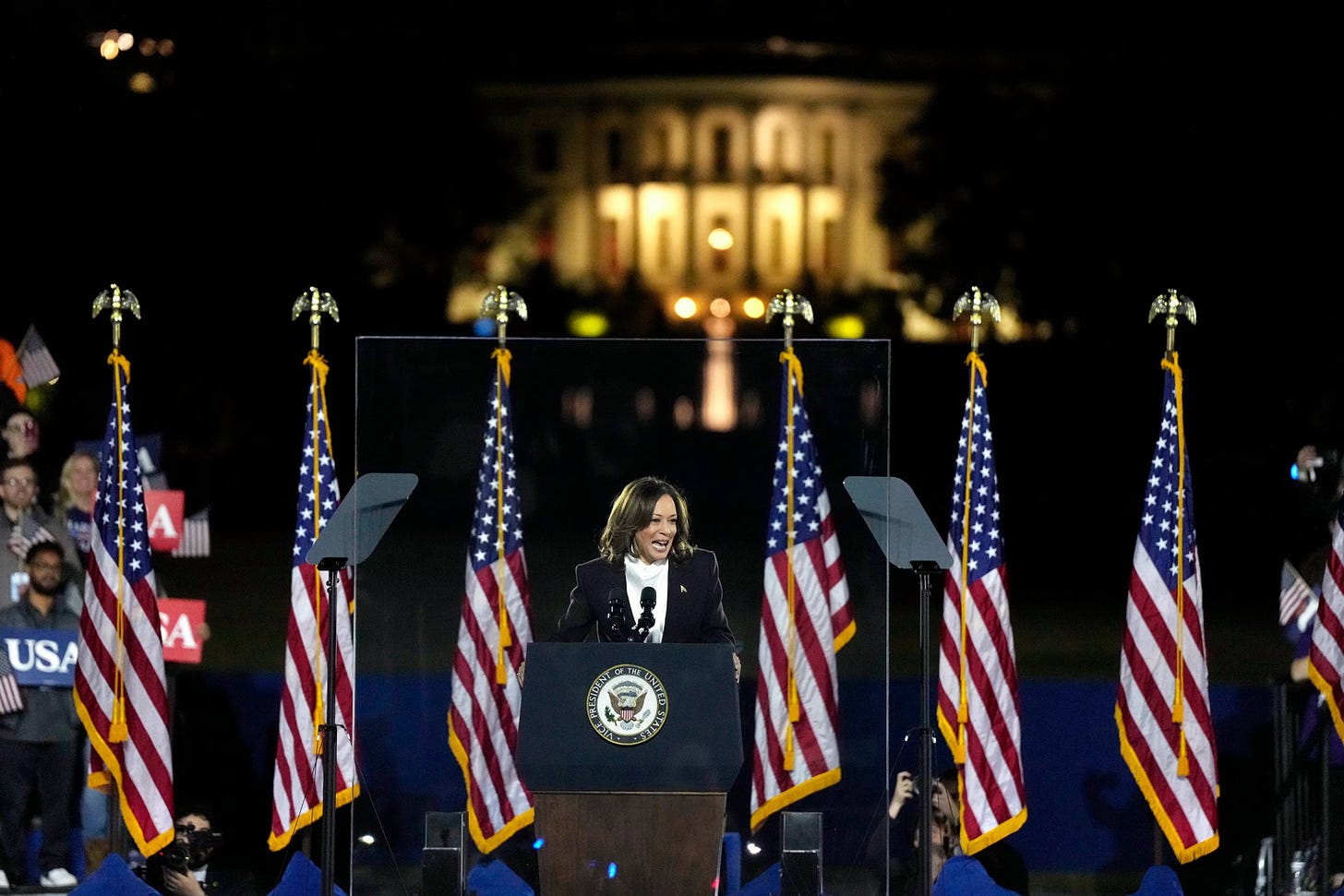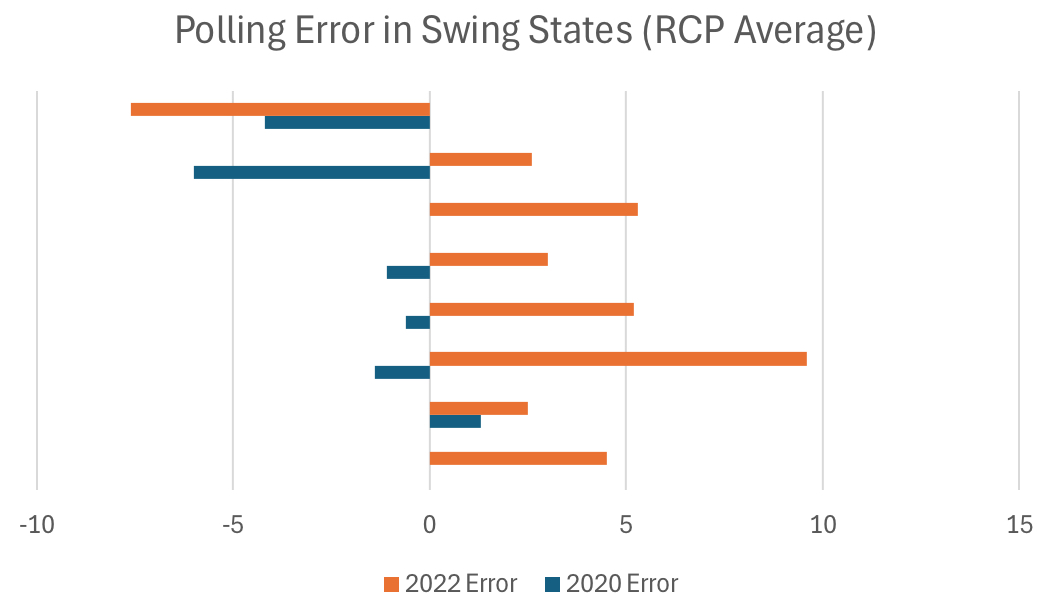The Tale of the Tape, 2nd November
Understanding the trends, polling, and campaigns of what could be the closest election since 2000
As we rapidly approach doomsday (AKA, election day) on Tuesday, many modellers, pollers, and onlookers have been scrambling to find a consensus on what the outcome of this election will be. On one fringe, there are radical hard-right conservatives like tech-tycoon Elon Musk who seems convinced that Trump has the election in the bag, tweeting posting his ambitions to turn ‘the blue states’ (likely referring to Virgina, New Hampshire, and other once battlegrounds that have now become Democratic fortresses), into ‘red’. Then, on the other side, there are Democratic wishcasters such as Christopher Bouzy, who are insists on the likelihood of a Blue Florida, Ohio, and Iowa, a throwback to the electoral predictions of a decade ago, despite the huge shifts red those states have seen (case in point, Ron DeSantis winning Florida by 20 points in 2022). However, most of us lie somewhere in the middle, caught between the crossfire of the relentless guesswork that is predicting elections, and gearing up for what could be one the closest elections the US has ever seen.
Polling Rights and Polling Wrongs
Trust in general election polling has plummeted from all sides of the electorate, in large part due to their colossal errors during the 2016 and 2020 elections, in which pollsters massively underestimated the performance of DJT.
However, polling error is not just some linear, constant thing. For starts, the error varied by state, as seen below.

To make the issue of polling accuracy even more complicated, the errors were completely flipped around in the 2022 midterms, when the ‘red wave’ was changed into a mere puddle, aptly demonstrated visually below.
There are several things to take any from this. Number one, no, Democrats are not getting close to winning Florida. Number two, is that polling may be fundamentally broken - and that the pollsters themselves know it. As speculated by NYT columnist Nate Cohn and polling guru Nate Silver, some pollsters have began a trend of herding - intentionally either not releasing outlier polls, or altering their adjustment models until their polls create a result that is line with consensus. This has lead to a barrage of polls with 1 to 0 point margins, something that is very unhelpful for trying to get a wider outlook on the race. A good example of this is the polling firm Redfield & Wilton, which had all 7 swing state races within 1 point, which Nate Silver calculated to have a 1 in 175 million chance of being a close as it was. Additionally, many pollsters that produced more left leaning results - SurveyMonkey, Public Policy Polling, Targoz Research, Swayable, and more, have either stopped polling US elections altogether or massively scaled back operations due to their errors that occurred in the 2020 elections. Meanwhile, this has left right leaning pollsters - Atlas, Rasmussen, Emerson College, still open for business, creating a polling imbalance - which in no small part lead to the errors of 2022.
This ‘herding’ of polls has lead to very strange changes in the landscape of models. For example, here is the adjusted swing state margins of my model, which takes into account different possible polling errors, over time from mid-August to today.
Polls have been relatively normal for the first three quarters, until some mystery event in mid-October decided that this election could not be decided by any margin greater than one, which has lead to wild fluctuations in the dying days of this race. Anyone who tells you that they know what way the polls are wrong (or if the polls are actually right), is lying - there are simply too many variables, whether it be female turnout from abortion, the shifting demographics of each party (particularly amongst Latinos), or the sheer aura of Trump, bringing voters to the ballot box in droves, out of love or hate.
Early Voting Isn’t Real, it Can’t Hurt You
Both sides of the political spectrum are currently stat-staring at early voting numbers, and both sides seem to be interpreting in completely opposite ways. On the republican side, they look at early voting numbers in 2020, then 2024, then declare a Trump victory.
“[Registered] Democrats lead early voting by 14.3% in 2020. Now they only lead by 2.8%. Trump is winning every swing state, and more! Why else would he campaign in Virginia?”
Meanwhile, Democrats look at the demographics, of early voting, especially gender, and claim victory.
“Female turnout in 2024 is at 54.2% in key swing states, several points higher than 2020. Women are turning out to protect abortion rights, and will defeat Trump this November!”
But in reality, early voting is mostly inconclusive. For a start, comparing early voting numbers to 2020 may be the least helpful exercise possible in this regard. COVID meant historic levels of early voting, and one of the candidates actively lambasted early voting, while the other encouraged. Therefore, early voting was very Democratic. Now, while Trump is actively encouraging early voting, this has lead to a predictable shift right for early voting numbers. However, we currently know nothing about the behaviour of these voters. We have no idea how many of these early GOP votes are simply eating into their election day vote. We have little idea what the actual votes are from these early voters - for example, the large numbers of registered republicans could be disaffected Haley voters, while the registered Democrats could be blue collar workers won over by Trump. Additionally, independent splits are also very vague, as there are growing numbers of young voters who are left-leaning, yet still registered as independent. Therefore, my conclusion is that early voting numbers are quite useless.
Shifting Demographics and the Mystery of Haley Voters
One of the more informative polls we have received in the last weeks was an ABC/Ipsos poll, that very usefully, contained Demographic breakdowns for each candidate.
There are many takeaways from this poll, but the one I would take the highest note of is the margins amongst three groups - college graduates, suburban voters, and young men. These three groups highlight in particular the paths to victory for each candidate.
College graduates have been trending left for over a decade now, and they are key to Harris winning the election. Notably, college graduates are strongly connected with two key other traits - living in a suburb, and being middle-class.
Harris is banking big on winning these college educated, middle-class, suburbian voters, explaining why she has significantly moderated her image from Medicare-For-All progressive in 2020 to pragmatic bipartisan leader in 2024. A lot of her rhetoric on the economy revolves around ‘strengthening the middle class’ following price increases that have happened during the Biden administration, whether it be her child tax credit, or small business tax credit (note the use of tax credits, more fiscally conservative language, even if they achieve very similar results to subsidies). Not to mention, her constant mention of her ‘middle-class upbringing’. This has seemed to pay dividends for Harris - showing her leading the issue metric of ‘who would be best at looking out for the middle class’ by 6 points, while Trump leads metrics of ‘the economy’ and ‘inflation’ by 8 and 7 points.
The use generational gaps of voting behaviour seem to breaking down in Trump’s favour, with young people, especially young men voting for Trump far more than in 2020. On the left, this is often blamed on the washed up commentator to major right wing internet sensation ‘pipeline’, generating figures such as Andrew Tate and Ben Shapiro, as well as the rise of toxic masculinity amongst males.
Many of Trump’s surrogates seem to be squarely focused on this demographic group, with figures like Charlie Kirk and the aforementioned Ben Shapiro using their influence in the ‘manosphere’ to sway this group. Trump’s visit on Joe Rogana show massively popular amongst young men, as well as the selection of young Senator JD Vance also suggests this as a key target of the Trump campaign.
The final demographic I would mention as looking out for, especially if you are a Harris supporter, is the elusive group of moderate Republicans who voted for Nikki Haley ahead of Donald Trump in the 2024 Republican Primaries. In the state of Pennsylvania alone, there were over 150,000 of these voters, who could easily be enough to sway the election in that state. Historically, trying to appeal to Republicans who may be turned off by Trump’s rhetoric has not been very effective for Democrats - however, there is reason to suggest that this time may be different.
Neither candidate in 2020 or 2016 really tried for this group. In 2020, Biden made a very concerted effort to win the progressive vote, which resulted in a surprisingly left-wing campaign. He was a vocal ally of BLM movements, appointed a VP designed to appeal to progressive movements, and also made several concessions to Bernie Sanders to secure his unwavering support. Clinton occupied an awkward middle ground, trying to appeal to both progressives and republicans, which resulted in her failing to secure either, a large missed opportunity, given the number of mistakes made by Trump in 2016.
In 2024 however, Harris seems to be going all out. Many of her proposals are laser-targeted at this group, as I will list.
Promised to create a bipartisan committee of advisors in her administration.
Promised to appoint a Republican(s) into her cabinet.
Many campaign stops accompanied by Republican Senator Liz Cheney.
Border security is a major part of her platform, promising to revive the Bipartisan border bill.
Very frequently brings up endorsements of former Trump secretaries/older Republicans, like Dick Cheney.
Harris would only be doing this if she knew/thought it was working, so Democrats should keep close watch at this demographic come election night.
What the Models Say
To conclude, I thought I would leave you with the thoughts of the real election ‘professionals’.









